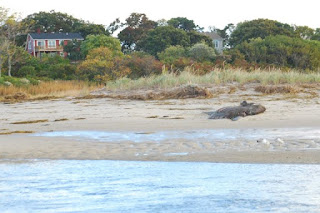
On April 8th, 2011 Krill, Tammy and Emily were invited up to the MA Division of Marine Fisheries' Annisquam River Marine Fisheries Field Station to meet Scott Elzey and his team (Katie L'Heureux and Kimberly Trull) to discuss possible aging techniques for ocean sunfish, Mola mola.
Since 2005, NECWA has conducted an ocean sunfish project through our NEBShark program. Each fall, over 20 ocean sunfish strand (mostly dead) on Cape Cod beaches. We are not sure why these individuals are stranding, but we do know that ocean sunfish are common visitors to our waters in the summer and early fall. They are attracted into our New England waters due to the high abundance of their favorite prey, jellyfish, ctenophores and other gelatinous zooplankton.
We spent the morning slicing, examining and working with the vertebrae of ocean sunfish that stranded on Cape Cod beaches this past season. We are hoping to use a banding technique similar to what is used for cartilaginous fish and some bony fish.
NECWA responds to as many stranded ocean sunfish as is possible and this season (2010) we helped release two live ocean sunfish and examined 18 dead carcasses. Our examinations involve the collection of photographs, body measurements and tissue sampling. One piece of information that we are hoping to learn is the age of the sunfish that strand each fall on our beaches.
Many species of bony fish are aged using hard, calcified structures in their inner ears called otoliths. A standard practice for aging studies is to collect, stain and section otoliths counting the visible rings to determine the age of the fish. You would think that being classified as the "heaviest bony fish" in the world, the ocean sunfish would have largest, most well-developed otoliths of any species!
Unfortunately, the otoliths that we have collected from carcasses are small and not well developed. Therefore, we are hoping to use an aging technique developed for cartilaginous fish like sharks, skates and rays, since these species do not have otoliths. This technique requires that you section the vertebrae and examine banding patterns that are visible in this tissue.
Scott showed us a number of possible techniques that can be used with vertebrae and encouraged us to experiment with different methods including different ways of sectioning the vertebrae and staining the tissue. We had a lot of fun experimenting with the vertebrae we had collected and discussed the many pros and cons of each technique.
A big thank you to Scott, Katie and Kim for all their help, support and encouragement. We often don't meet professionals in the field that are just excited about this strange species as we are.
One of the amazing things about NECWA's ocean sunfish project is that it exemplifies the process of science and scientific exploration. When trying to learn about the biology and natural history of this very unusual marine fish, there are no easy answers and no guide books. Much of what we have learned to date has come by trial and error and by asking questions (and then more questions). It is "a process" in every sense of the word and a journey that has allowed us to meet some amazing people like Scott, Katie and Kim.
When we left Gloucester for home, are heads were spinning with all the possibilities. But we headed home with a renewed sense of enthusiasm and determination to create a meaningful aging technique for this species. We are looking forward to working on this project in the coming months and seeing what we can develop on our own.
Thanks again for Scott, Katie and Kim for a fun and rewarding Friday. And thanks to Katie for the photos in this posting. We look forward to working with this amazing team once again and to additional collaborations in the future.










Comments
Post a Comment